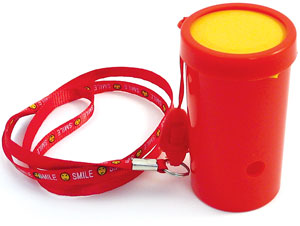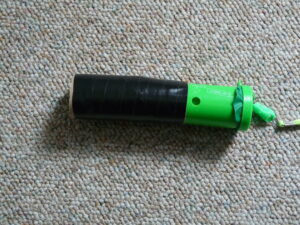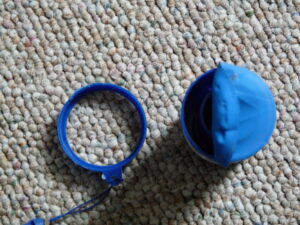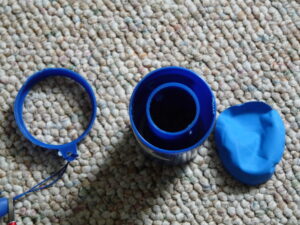 by: Norman Barstow
by: Norman Barstow
Frequency, Wavelength and Pitch:
Sound is a tone you hear as the result of regular, evenly spaced waves of air molecules. The most noticeable difference is that some tones sound higher or lower than others. These differences are caused by variations in spacing between the waves; the closer the waves are, the higher the tone sounds. The spacing of the waves – the distance from the high point of one wave to high point of the next one – is the wavelength.
All sound waves travel at about the same speed in a given medium. So, waves with a longer wavelength don’t arrive (at your ear, for example) as often (frequently) as the shorter waves. This aspect of a sound – how often a wave peak goes by – is called frequency by scientists and engineers.
The word that musicians use for frequency is pitch. The shorter the wavelength is, the higher the frequency, and subsequently the higher the pitch of the sound. In other words, short waves sound high; long waves sound low.
The Pocket Sound Blaster
Many instruments produce sound by vibrating a column of air inside a tube, e.g. flute, trumpet, and saxophone. A sound wave is created by a vibrating object. The actual frequency at which an object will vibrate is determined by a variety of factors including the object’s size, the material the object is made from, and the medium in which the sound wave is vibrating.
Since frequency = speed/wavelength, an alteration in either speed or wavelength will result in an alteration of the natural frequency.
When you blow into the side hole of the Pocket Sound Blaster, (SNG-600) the  rubber diaphragm vibrates as air pressure repeatedly increases and then is released. The vibration then resonates through the chamber and exits through the open end of the tube.
rubber diaphragm vibrates as air pressure repeatedly increases and then is released. The vibration then resonates through the chamber and exits through the open end of the tube.
Activity #1:
As you blow into the hole of the Sound Blaster, lightly touch the diaphragm to see whether the sound changes. Does the pitch get higher or lower? Drummers can change the tension on their drum-heads to change the pitch.
Activity # 2: Slide Trombone
As you blow into the hole of the Sound Blaster, insert your other hand’s thumb and move it in and out. Notice any change in pitch? For longer tubes, use a cork on the end of a barbecue skewer or thin wooden dowel to change the column of air and to make your own ‘trombone’.
Activity #3: Length of the tube (column of air)
Use cardboard tubes (toilet paper, paper towels, mailing tubes) of varying lengths to make the Pocket Sound Blaster tube longer. You’ll have to taper the ends of the cardboard tubes to make them fit the outside diameter of the Pocket Sound Blaster.
 Shorter is Higher — Longer is Lower: Change the length of this vibrating column of air by varying the length of a tube. Because the Pocket Sound Blaster is short, it produces a higher pitch or frequency. This happens because sound waves can travel, or vibrate, a shorter distance faster than a longer distance.
Shorter is Higher — Longer is Lower: Change the length of this vibrating column of air by varying the length of a tube. Because the Pocket Sound Blaster is short, it produces a higher pitch or frequency. This happens because sound waves can travel, or vibrate, a shorter distance faster than a longer distance.
Activity # 4:
Since the Pocket Sound Blaster tube is approximately 3″ long, make a series of card board tubes in 3 inch increments (3”, 6”, 9”, 12” etc.) to see how this affects the tone.
Activity #5:
The diaphragm of the Pocket Sound Blaster is held on by the plastic ring. Gently  remove the ring and explore with other diaphragm material: wax paper, parchment paper, zip bag plastic, other balloons, latex or Nitrile glove material, etc. What changes do you discover?
remove the ring and explore with other diaphragm material: wax paper, parchment paper, zip bag plastic, other balloons, latex or Nitrile glove material, etc. What changes do you discover?
Activity #6: Sound Energy
Can the sound from the Pocket Sound Blaster perform work?
- Try to blow out a birthday candle with the Pocket Sound Blaster.
- Put some confetti or puffed rice cereal in the tube and blow through the side hole. What happens?
- Hold the Sound Blaster so the rubber end is upright. Place some puffed rice on the latex and blow. Observe the movement of the puffed rice due to the vibration of the surface.

I have seen the Pocket Sound Blasters in catalogs, but have yet to actually hold one. To me it looks like a film canister with a rubber diaphragm at one end, and a hole poked in a side wall. Is this a fairly accurate description, or are there other pieces/features inside that I am unaware of?
Thanks for any insight you can provide.
Cindy Blobaum
Actually, it is a little different because the body of the horn is double walled. This allows the air pressure to build up until it slips past the rubber diaphragm. The vibration resonates through the hollowed out cylinder and exit from the open end. Hope that helps. We do have instructions to build your own stadium horn. If you would like me to send them to you, please call me at 888-912-7474. Ask for Tami.
Hold on a minute ! Wow ! I just discovered that a piece of 3/4′ pvc plastic plumbing pipe will snugly fit into the inner hole of the sound blaster. we attached the blaster to a six foot length of pipe and the deepest bass sound resonated…. just incredible…. we could sense each pulse of a 20 hertz vibration
much better than making paper cones for the exterior of the blaster. We’re making pieces of pvc pipe in a variety of lengths to match notes on the piano
Awesome! Can you share pictures when you’re done? We’ll have to try that here, too! Thanks for the discovery!
~Tami
Educational Innovations
I blew into the side hole and got very little sound. It made barely any sound. What am I doing wrong?
Hi Nancy,
I think you just need to blow harder. Don’t be shy. You’ll get a great booming sound!
~Tami
Educational Innovations
Can these be sanitized?
Unfortunately, not very well.